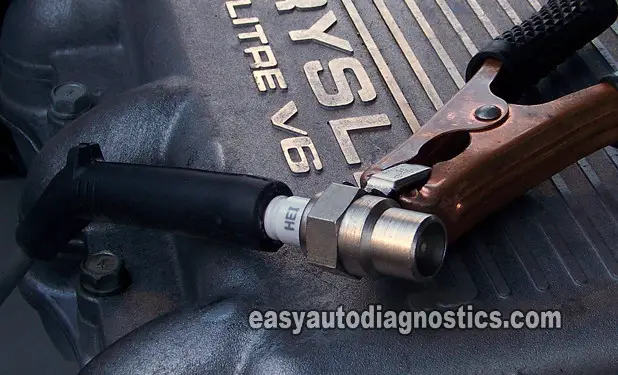Do's And Don'ts When Testing For Spark
Whether your vehicle has a distributor, or a DIS coil pack type system or a Coil-on Plug (COP) system, I suggest that the very first thing you should do in your diagnostic (of the no-start condition) is checking for spark. I'm gonna' give some helpful and effective testing tips in the next couple of paragraphs.
When testing for spark, it's very important to use a spark tester. Not just any tester will do. I recommend the HEI Spark Tester (the HEI stands for High Energy Ignition). If you want to know more about this tool, you can take a look at this article: The HEI Spark Tester. This article is within this site and is about how this tool works.
Using anything else or any other method will give you a false test result that'll have you wasting time and money. Not only that, you could damage the ignition coil in the process. Here are some specific examples of what not to do:
- Pulling the spark plug wire off of the spark plug while the engine is cranking to check for spark.
- Using a regular spark plug, instead of a dedicated spark tester tool, to test for spark.
- Using a timing light's flashing ON and OFF to verify if spark is coursing thru' the spark plug wire.
What The Spark Test Diagnoses
The components of the ignition system that the spark test is testing are:
- The ignition coil.
- On distributor type vehicles:
- The distributor cap.
- The distributor rotor.
- The spark plug cable.
- On distributor-less vehicles:
- Just the ignition coil(s).
- On distributor type vehicles:
Photo 2 belongs to a distributor-less ignition system and photo 1 to a distributor type system. The HEI spark tester is attached to the end of either the ignition coil boot or the spark plug cable.
After connecting the spark tester. You'll need to have an assistant crank the engine. You should see and hear a continuous spark crossing the air gap between the center electrode and the outside casing of the tester. Here are a few things to keep in mind:
- On a distributor type system it's important to test all of the spark plug wires and the ignition cable that feeds the spark from the ignition coil do the distributor cap. Why? Here are the three main reasons why:
- To find out if some of the spark plug wires are not delivering spark.
- This would cause the engine to flood out with gasoline, thus causing a no-start.
- To find out if the distributor cap is receiving spark but isn't sending it out to the spark plugs.
- This could be caused by the cap itself or the rotor. This is a very common no-start cause.
- To find out if there's no-spark at all, anywhere. If so the most likely causes are:
- The fuse that feeds power to the coil(s) is blown.
- The relay that feeds it this power is bad.
- The ignition module is bad.
- The crankshaft position sensor is bad.
- To find out if some of the spark plug wires are not delivering spark.
- On a distributor-less system, testing two to three coils should suffice. Why?
- The odds that all of the coils are bad at the exact same time are astronomical! In my experience I have never seen it happen.
- But if you have no-spark at two or more coils. The most likely causes are:
- The fuse that feeds power to the coils is blown.
- The relay that feeds it this power is bad.
- The ignition module is bad.
- The crankshaft position sensor is bad.
When you test for spark, all you're doing is trying to get a starting point for all of your tests. Why? because depending on whether you get spark or not, you will need to follow this up with more specific tests.
So, if you spark at more than one point (remember you have to test several wire or coils) or better yet, spark at all cylinders. Then you can forget about the ignition system as the cause of the no-start condition.
By seeing spark at multiple points, you now know that the ignition coil(s), the distributor, the distributor cap and rotor, the spark plug wires, ignition module and crankshaft position sensor are good. All of these components comprise the entire ignition system and you have just eliminated them.
All right, the next step is to check fuel pressure. This is a must whether you get spark or not. Why? Because it's crucial to make sure that the ignition system is the only system not doing its job. But this part belongs to the next page, so lets go there.


